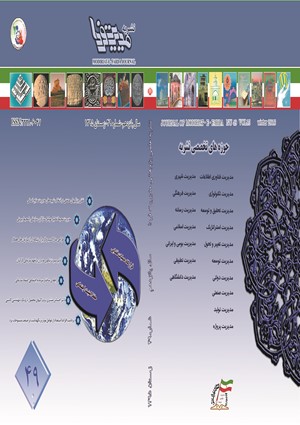ارائه مدل برنامهريزی چند دوره¬ای برای طراحی شبکه صادرات عسل با در نظر گرفتن الزامات کیفی محصول
محورهای موضوعی : مدیریت صنعتیعليرضا گريواني 1 , میرسامان پیشوایی 2
1 - دانشگاه علم و صنعت ايران
2 - دانشگاه علم و صنعت
کلید واژه: طراحی شبکه زنجیره تامین بین المللی قیمت انتقالی نرخ ارز صادرات عسل,
چکیده مقاله :
عسل محصولی است که از گذشته به داشتن فواید بسیار مشهور گشته است. کشور ایران دارای شرایط آب وهوایی مناسب برای پرورش زنبور عسل می باشد و در تولید عسل از جایگاه خوبی در میان کشورهای جهان برخوردار است. اما به دلیل رعایت نکردن مسائل مربوط به کیفیت، صادرات عسل از این کشور به سایر کشورهای جهان با مشکلات فراوانی همراه است. همچنین کیفیت عسل نقش مهمی در تعیین قیمت فروش آن دارد. در این پژوهش، سعی شده است با توجه به این موضوع، شبکه صادرات عسل طراحی گردد. برای این منظور یک مدل ریاضی عدد صحیح مختلط چند دوره ای ارائه شده است که در آن الگوی تقاضا در کشورهای واردکننده عسل براساس سطح کیفیت عسل در نظر گرفته شده است. به کارگیری این مدل در واقعیت موجب ساماندهی به وضعیت صادرات عسل ایران خواهد شد، چنان که بر اساس نتایج حل مدل، صادرات عسل به هر کشور براساس تقاضای آن کشور در سطح کیفیت خاصی صورت می-پذیرد که الزامات آن در فرآوری عسل باید مد نظر قرار گیرد.
From the past, Honey has been known as a healthy product for human life. Iran has a suitable climate for beekeeping and is among the high-ranked countries in honey production. However, due to failure to comply with quality issues, export of honey from this country is associated with many problems. Honey quality also plays an important role in determination of honey sale price. According to this issue, in this study, the design of honey export network is taken into account. For this purpose a mixed integer programming mathematical model is developed which is able to consider the impact of honey sale price on demand quantity of importing countries. The numerical results show that the proposed model can efficiently determine the strategic network design decisions and help the managers in this regard.
[1] Syam, S. S. (1997). A model for the capacitated p-facility location problem in global environments. Computers & operations research, 24(11), 1005-1016.#
[2] Goetschalckx, M., Vidal, C. J., & Dogan, K. (2002). Modeling and design of global logistics systems: A review of integrated strategic and tactical models and design algorithms. European journal of operational research, 143(1), 1-18.#
[3] Baghalian, A., Rezapour, S., & Farahani, R. Z. (2013). Robust supply chain network design with service level against disruptions and demand uncertainties: A real-life case. European Journal of Operational Research, 227(1), 199-215.#
[4] Delfmann, W., & Albers, S. (2000). Supply chain management in the global context. Arbeitsberichte des Seminars für Allgemeine Betriebswirtschaftslehre, Betriebswirtschaftliche Planung und Logistik der Universität zu Köln.#
[5] Hodder, J. E., & Jucker, J. V. (1985). International plant location under price and exchange rate uncertainty. Engineering Costs and Production Economics, 9(1), 225-229.#
[6] Hammami, R., & Frein, Y. (2014). Redesign of global supply chains with integration of transfer pricing: Mathematical modeling and managerial insights. International Journal of Production Economics, 158, 267-277.#
[7] Munson, C. L., & Rosenblatt, M. J. (1997). The impact of local content rules on global sourcing decisions. Production and Operations Management, 6(3), 277-290.#
[8] Sheu, J. B., & Lin, A. Y. S. (2012). Hierarchical facility network planning model for global logistics network configurations. Applied Mathematical Modelling, 36(7), 3053-3066.#
[9] Hammami, R., & Frein, Y. (2013). An optimisation model for the design of global multi-echelon supply chains under lead time constraints. International Journal of Production Research, 51(9), 2760-2775. #
[10] Canel, C., & Khumawala, B. M. (1996). A mixed-integer programming approach for the international facilities location problem. International Journal of Operations & Production Management, 16(4), 49-68.#
[11] Goh, M., Lim, J. Y., & Meng, F. (2007). A stochastic model for risk management in global supply chain networks. European Journal of Operational Research, 182(1), 164-173.#
[12] Syam, S. S. (2005). A model for the capacitated p-facility location problem in global environments. Computers & operations research, 24(11), 1005-1016.#
[13] Badri, M. A. (1999). Combining the analytic hierarchy process and goal programming for global facility locationallocation problem. International Journal of Production Economics, 62(3), 237-248. #
[14] Hodder, J. E., & Dincer, M. C. (1986). A multifactor model for international plant location and financing under uncertainty. Computers & Operations Research, 13(5), 601-60.#


